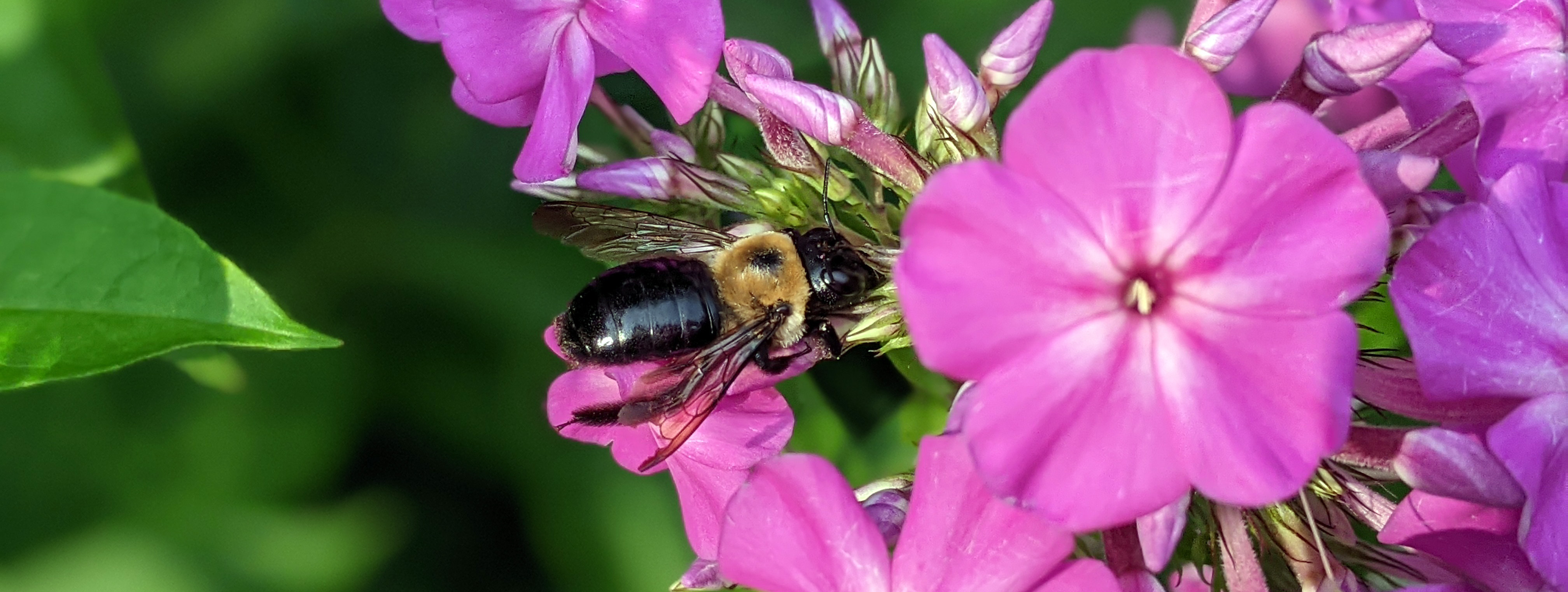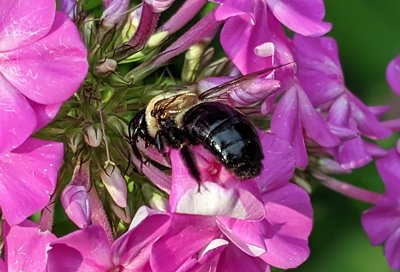
This lovely, large, and often somewhat awkward bee, is the Eastern Carpenter Bee, Xylocopa virginica (Family = Apidae). It gets its name from its excellent ability to excavate and build homes in wood. I say excellent, but X. virginica often gets a bad rap for its carpentry work. This is usually due to miscommunications with its wood suppliers (aka homeowners or other humans). Let’s try to clear up some of these miscommunications, shall we?
Firstly, the Eastern Carpenter Bee is an important pollinator of wildflowers and some agricultural crops like blueberries, apples, and plums. So far, it has been recorded to pollinate almost a 100 different flowering plants (see list at the bottom of the DiscoverLife page). The Eastern Carpenter Bee is native to North America and can be found throughout most of the Eastern US and Canada. It is one of only seven species of large carpenter bee (genus = Xylocopa) found in North America. They are often confused with super industrious Bumble Bee (genus=Bombus), but unlike the Bumble Bee, most of their abdomen (aka butt) is smooth instead of being covered in fuzzy hairs.

Although Carpenter Bees do occasionally exhibit “nectar robbing” behavior if the flower is too narrow for the bee to squeeze into, they do pick up the pollen load and go through the front entrance of most flowers like good bee citizens. Nectar robbing is basically where a bee, or other bug, skips picking up the flower’s pollen load and goes directly to the nectar reward - which is only there in the first place in order to entice bees to carry their pollen! This nectar robbing usually involves cutting through the outside of the flower to get to the nectar. Like when your dog can’t get to all the peanut butter you put inside their bone and they decide to just chomp through the bone instead of trying to lick it out… Yeah. Something like that. Not sure if cats have an equivalent, but dog owners will get this analogy lol.

To make small homes for them and their babies, the Eastern Carpenter Bee drills large holes into wood. They often prefer wood from conifer type trees (aka cone making trees like pines and cedars), but are happy to use most other wood including old dead trees, large branches, or logs for their homes if some of the bark has been removed. This is where one of the primary miscommunications comes in… Since humans have been so kind as to remove all the bark from lumber pieces and place them outside in large groupings, the carpenter bee naturally assumes we are purposely supplying them with wood in exchange for pollination services… Why else would we put so much bark stripped wood out in the open for them to find?

Further supporting the idea that we intended to give these bark free pieces of lumber to the carpenter bee, is that many lumber pieces are painted or varnished. Obviously, to the bees anyway, those pieces of wood with paint on them are being used for something - so the carpenter bees usually leave them alone. Makes sense to me… Treated wood is being used by humans, untreated/unfinished wood is for pollination services… Carpenter bees will sometimes use pressurized wood for their homes as well, but they generally prefer untreated wood. So in a way, they are actually trying to help the homeowner out by marking the pieces of wood or lumber that are either in need of some painting, getting old and need replacing, or if they used to be treated, pieces that now need to be re-treated. It’s basically a free service… Who doesn’t like free things, right?

The other common miscommunication that often happens between carpenter bees and humans is the human perception that carpenter bees are aggressive. While the male carpenter bees are often territorial around their nests and do quite a bit of macho showboating (as many male humans and other species have been known to do), they are all buzz and no sting. That’s right – the male carpenter bees CANNOT STING you! Stingers are actually modified ovipositors (egg laying devices) and since only females lay eggs, only the females can sting you. The dive-bombing and quick darting around your face is just something the males do. The females have much more important tasks to occupy their time – like building homes and collecting pollen to feed the baby bees. As long as you are not actively trying to destroy her home, it is rare for a female to take time out of her busy schedule just to sting one of the many curious passersby.

While not truly social, like honey bees (Apis mellifera), the Eastern Carpenter Bee is sometimes semi-social, and is often gregarious, meaning she likes to nest in small groups to be near her friends. Besides being friendly, an important pollinator, a good builder and excavator, X. virginica is also thrifty and environmentally conscious. The female Eastern Carpenter Bee often lives longer than most bees (usually 2-3 years!), and will frequently not only reuse the same nests year after year, but will also refurbish old nests instead of building brand new ones. Thrifty. I knew I liked X. virginica 😄
So what do you think? Willing to give this carpenter another chance now that we’ve cleared up some miscommunications?

To read more about Eastern Carpenter Bee, check out these resources:
Support the blog
Like my blog? Want to help keep the new content coming and the pages ad free? Consider becoming one of my Patreon Patrons! Any amount, big or small, helps me spend more time creating and less time trying to keep the lights on. Patreon Patrons can also get exclusive access to monthly newsletters, story sneak peeks, story requests, and more! Please consider supporting the blog and check out my Patreon Patron support page.
Ok, you say, but what is this Patreon thing you are talking about? Patreon is a service that helps connect content creators with folks who want to help support creative endeavors. Patreon is setup to be able to safely handle the financial side of transactions so both the patron and the creator can be confident their information is secure. You can read more about what Patreon is HERE.
Thank you!!
Not interested in a Patreon monthly subscription? Prefer to make a one-time contribution? We have that option too! Help support the blog with a one-time donation through PayPal instead! Thank you!!
Gifts & Swag Galore
Now you can get prints of some of our favorite critters on Red Bubble! Everything from tote bags and pillows, to greeting cards and note books, to t-shirts and mugs!
Check out it out HERE. The store is organized by design, so pick a critter picture to see all the gift options :)
Here are just a few examples:
And so much more! Check out all the bug patterns HERE.
Join the email list
Want Bug News stories & announcements sent to your inbox? Never miss a story: Join the Bug News email list here or email me at Erika@bug.news with “Join email list” in the subject line.
Questions? Comments? Corrections?
I’d love to know what you thought and what’s on your mind. Email it to me at erika@bug.news. I’ll do everything I can to answer your questions, address your comments, and keep the stories updated :)
We’re also on Facebook so you can leave a comment or start a discussion there too if you prefer that medium…
















